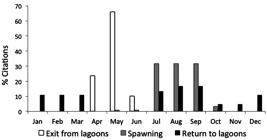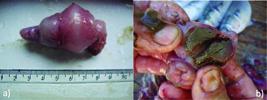This research investigates local ecological knowledge of fishers in communities along a latitudinal gradient in the coast of the Santa Catarina State, regarding the life cycle of mullets Mugil liza (migration, feeding, and reproductive behavior). Our sampling encompassed eight Santa Catarina coastal cities (nine artisanal fishing sites) and engaged 45 key informants (28- 86 years of age) through semi-structured interviews from August/2011 to March/2012. This fish species feeds and grows in lagoon and estuarine systems, migrating to the sea for reproduction, and spawning. Fishers acknowledged the Patos Lagoon and the Plata River as the main source of mullet schools. Migration occurs from South to North and the routes vary according to climatic and oceanographic conditions (e.g., low temperatures, south winds, rainfall, currents, salinity). These conditions influence the abundance of mullets (and therefore fisheries success), their migration and stops in locations such as beaches, rocky shores, and islands. According to fishers, mullet spawning occurs throughout the coast of the Santa Catarina State and they feed in lagoons and riverine systems but also out at sea during migration. In conclusion, fishers possess a detailed knowledge about mullet life cycle and they identify intra and interannual variations in migration routes, a pattern that should be considered in managing the fishery.
Artisanal fisheries; Ethnoecology; Feeding; Mugilidae; Reproductive biology

 Thumbnail
Thumbnail
 Thumbnail
Thumbnail
 Thumbnail
Thumbnail
 Thumbnail
Thumbnail
 Thumbnail
Thumbnail




